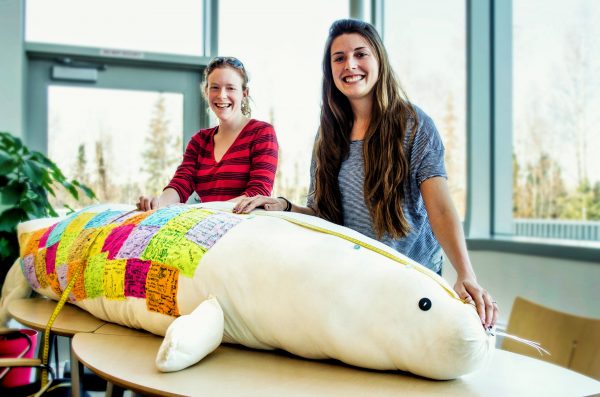UAF grad student searches for seals in children's book
November 7, 2017
Meghan Murphy
907-474-7541

Download text and photo captions here.
Given that a small Weddell seal can weigh 850 pounds, Roxanne Beltran didn’t mind carrying a fabric model of one filled with 25 pounds of cotton stuffing.
The University of Alaska Fairbanks doctoral student toted the hand-sewn prop — named Patches — to many elementary schools in Alaska. She fielded hundreds of questions about her research on the Antarctic seals.
But there was one question from a third-grader in Fairbanks’ Ticasuk Brown Elementary School that Beltran decided needed a 750-word reply.
"A student asked if I would write a kids book about Patches so that her dad could read it to her every night,” Beltran said. “I came home that night and told my fiancé Patrick that we have to write a book.”
Patrick Robinson is a seal biologist from California who accompanied Beltran on some research trips to Antarctica and helped her stitch Patches together.
They wrote the 48-page book, “A Seal Named Patches,” which the University of Alaska Press published in November 2017. In the book, Beltran and Robinson are scientists looking for a seal that they’ve been tracking since birth. The story is geared toward children ages 5 to 8, although photo captions have information targeted at adults.

“We hope to inspire young readers by allowing them to see the incredible beauty of Antarctica, the amazing adaptations of the seals, the nerve-wracking excitement of fieldwork, and the thrill of flying in a helicopter over the ice,” Robinson said.
While Beltran and Robinson portray themselves, they admitted that Patches is a combination of their two favorite seals, Little Red and Very Old Mom.
“Little Red was the smallest seal we’ve ever handled, and we used her length and girth measurements to make the life-size Patches that we brought to schools,” said Beltran. “Very Old Mom was a seal who lived to be 30 and birthed 21 pups over the years, like Patches in the book.”
The stuffed, replica Patches was one of the highlights of an educational program for school children that Beltran created with another graduate student, Amy Kirkham, while they were studying Weddell seals through the University of Alaska Anchorage. Beltran continued the educational program in Fairbanks when she became a Ph.D. candidate in biological sciences at the UAF College of Natural Science and Mathematics.
In just four years, the graduate students taught 4,000 Alaska students about the southernmost mammal and its adaptations to extreme cold. Students signed their names on colorful squares of cloth, which became patches on the eponymous seal.
Although Beltran and Robinson wondered about making the life-size Patches into an illustration, their publisher persuaded them otherwise.
“One of the most difficult decisions in creating this book was deciding whether to use pictures or illustrations,” Beltran said. “Not many people get to go to Antarctica, and the photographs show what it’s really like down there.”
The two avid photographers had plenty of pictures to draw from. While at UAF, Beltran visited Antarctica seven times with Robinson. He accompanied her on the first and last trip as the team’s seal anesthesiologist. During that time, Beltran collected data on thousands of seals each year.
Beltran's research team visited the Weddell seals twice a year for four years during Antarctica's summer. Each year, the two trips were divided between the pupping and molting seasons. Through her research, Beltran found that Weddell seal moms shed their fur about two weeks later than female seals that don't give birth and are more likely to skip pupping the next year. Beltran said knowing timing relationships like these can help scientists better understand if environmental factors like climate change might disrupt the pupping or molting seasons.
Beltran studies with Greg Breed, an associate professor of biology at UAF’s Institute of Arctic Biology, and Jennifer Burns, a professor of biological sciences at UAA. The National Science Foundation funds the research through an Office of Polar Programs grant and Beltran’s salary through a prestigious Graduate Research Fellowship.
Her co-author Robinson is a reserve director for the University of California Natural Reserve System, where he studies how marine predators make a living in the open ocean. He works with a variety of researchers to attach tracking instruments to free-ranging seals and sea lions.
Both said that they're ecstatic that Jane Goodall, a famous primatologist, endorsed the book.
Robinson said they might also write a book about an elephant seal named Phyllis that he helped track under the guidance of UC Santa Cruz professor Dan Costa.
“She almost made it to Japan — farther than any seal we’ve ever tracked,” he said. “Then she went offline for a while, and we thought she might have passed away, but she unexpectedly reappeared on the beach in California a few months later!”
However, Beltran said, the second book will have to wait until she's done with her thesis.
“It’s lucky that when we write scientific papers, they can be nine- or 10-thousand words. We can pack in a lot of information,” she said. “Trying to fit all that information into a short children’s book without too much jargon is challenging — but a worthwhile endeavor to inspire the next generation of scientists.”
For more information online, go to https://www.alaska.edu/uapress/browse/detail/index.xml?id=556.
ADDITIONAL CONTACTS: Roxanne Beltran, roxanne.beltran@gmail.com; Patrick Robinson, patrick.robinson@ucsc.edu


